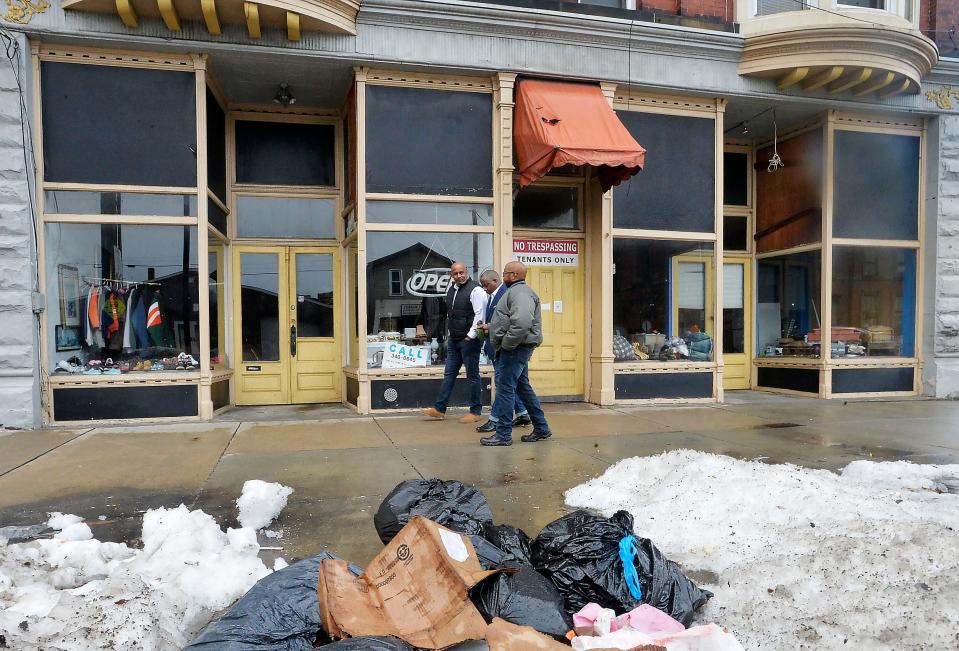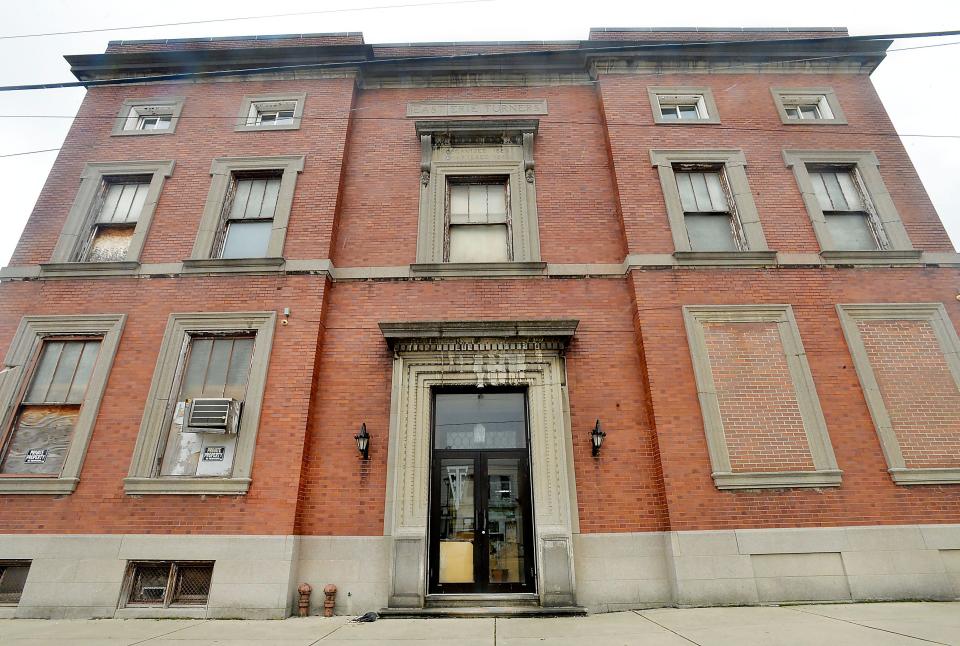East Side Renaissance, the ‘wholesome, serious transformation’ Erie needs
When we talk about the new downtown Erie, what comes to mind? Crowds with plates piled high at the Flagship City Food Hall? Friends tugging giant Jenga blocks at Oliver’s Beer Garden as the sun sets over Presque Isle Bay? Or maybe it is the public art celebrating Erie’s Black history and funky new bench swings at west Erie’s stunning Bayview Park.
And in east Erie? The good work done for decades by the Bayfront East Side Taskforce, after all, only extends so far.
There’s an ugly dividing line in downtown Erie’s rebirth that only grows more conspicuous and demanding of redress with each new win elsewhere. It is as black and white as the “Twilight Zone” Bishop Dwane Brock says he enters as he hits Parade Street heading east.
More: East Side Renaissance: Erie group eyes multimillion-dollar upgrades along Parade Street
"When we look at Erie, Pennsylvania, it is nothing more than a tale of two cities,” Brock said. “We have the haves and the have-nots and most of our economic development and concerns and stimuli has been on the west side, the downtown district and whatnot. The east side has been a forgotten commodity."
Erie’s 2016 comprehensive plan Erie Refocused essentially said, “so be it.” With a scarcity mindset fueled by the city’s dire trajectory after generations of job and population loss, it called for disciplined investment in the downtown core to flip the upside-down real estate market and restore the cratering tax base.
For the heart of the east side and its blistering concentration of civic sins — blight, disinvestment, and poverty rates that rank among the worst in the nation? Mass demolition, elevation of historic landmarks and the creation of green space. The demolition and vacant land management, it said, could be used as job training and development opportunities. As for the residents? No clarion calls for inclusion and equity. Instead, it suggested surrounding communities should share the burden of hosting them.

East side conditions no accident
The east side’s pressing human needs are easy to shrug off if you conclude they arise from individual failings or eye them with ruthless triage in mind. But history tells us there’s little organic about this landscape. A wicked maelstrom of hateful intent, including redlining and restrictive deed covenants, and global economic and retail forces unfolding over decades, rendered the Parade Street corridor a shabby, hopeless shadow of its former self and tilted the playing field against its occupants. As the Erie Times-News has reported, the area's median household income is just above $19,000 a year, and 56% of residents live below federal poverty guidelines, according to census data.
The deprivation reflected in those numbers is part of why experts at the Urban Institute in 2016 ranked Erie among the worst of the nation's 274 largest cities when it comes to the linked metrics of inclusion and economic health. Erie came in 254th in overall inclusion, 259th in racial inclusion and 249th in economic health.
It will require will, vision, collaboration, and prodigious sums of money to change the east side's course.
But that is exactly what is being deployed elsewhere in this city. Erie donors and investors led by Erie Insurance, local banks, universities and hospitals, grassroots activists and charitable organizations are changing Erie quadrant by quadrant. It is why Erie in key national conversations no longer serves as a Rust Belt punchline but instead a model of the New Localism — in which cities seize their own destinies by deploying local capital and solutions. We applaud the Erie Downtown Development Corp. for leading this effort to compelling effect even amid the pandemic. But any authentic appraisal of overall progress can't simply excise brute realities that lay just to the east — as much a part of the city as Perry Square or Gridley Park.
More: Our view: EDDC forges ahead with Erie renewal
Humane, layered approach
Enter the East Side Renaissance, an initiative formed by Bishop Brock, Marcus Atkinson and Matt Harris, three Black men — Erie leaders — equipped in life experience, connections and track records to dream and labor at scale to elevate a long-suffering hemisphere of the city. The aim, not to get rich, not to heal the tax base — though that will be a part of it — but to act with intent to disrupt historic trends that squander vital Erie assets — both human potential and Parade Street, once the city’s most celebrated corridor.
As Jim Martin and Kevin Flowers reported, these leaders of the East Side Renaissance plan a humane, layered strategy: Real estate development to address the dearth of fresh food, banking and retail outlets, and affordable, attractive housing; paired with capacity-building programs to ensure marginalized residents have the skills and confidence to access and seize opportunity.
“The property is just the vehicle to revitalizing the people. The primary thing is the people,” Atkinson said.
“We have the same vision — to bring about a wholesome, serious transformation in Erie, Pennsylvania,” Brock said.
Along with a bank will come instruction in financial literacy, wealth-building and the steps to homeownership. Along with a “crisp, clean” Wegman’s-style grocery store and housing improvements will be opportunities for young people to train and acquire job skills.

The 1890 East Erie Turners building, with weathered plywood covering some windows and others bricked-in, stands at the heart of the project. It’s been closed for seven years and in 2014 was the site of a shooting that claimed the life of Atkinson’s cousin, Rashid Anderson, amid a devastating explosion of youth gun violence. They envision reclaiming the space as a center of culture and pride, establishing a social club with entertainment and fine dining in the style of the Harlem Renaissance. As Atkinson said, when Erie companies try to recruit African American talent, those job candidates want to know “What does my nightlife, my socialization look like?” There is no place to point to, he said.
“This would solve an Erie problem,” he said.
For the same reason, it matters that three Black men lead this effort. It is not just that Erie struggles to recruit diverse talent thanks to our segregated landscape. We struggle to retain our own. So many young Black Erieites pursue their dreams in cities like Atlanta or Charlotte because they do not see their community represented and thriving — or even clearly welcomed — across so many Erie sectors, be it education, business, justice or government. Why should Erie, with decades of unstaunched loss of human capital, surrender that talent without a fight?
Plan well underway
The East Side Renaissance plan is not newly hatched or an idea without substance. The men have been working on it quietly for at least three years. They sought expert input on the planning, financing and purchases. Through Eastward Ventures LLC, they’ve purchased or have commitments to purchase 18 properties on Parade Street and the surrounding area and have a verbal agreement on East Erie Turners.
They plan to focus first on the East Erie Turners and other sites on that block to create a vibrant anchor, featuring a bank and grocery store, from which to expand. Those outlets would augment existing successful businesses, such as the iconic Kraus Department Store and Dave Stuck’s businesses to the south, including Denny's Ice Cream Stand.
They have gained local financial support in the seven-figures and in-kind donations but cannot yet name the backers.
Foundational to Erie's fortunes
They will need so much more to succeed. Given the stakes, they should receive it. What they aspire to, in our view, is as foundational to Erie’s fortunes as the EDDC’s patient capital play save the downtown core.
More: Opportunity Zone promise becomes reality in Erie
The pitfalls could be many. Best practices deployed in other cities looking to heal blighted, sidelined neighborhoods should be sought out.
As Flowers’ reporting details, east side residents and business owners see a need for the East Side Renaissance and are eager to learn more. Robust engagement must follow. Transparency and community agency and buy-in will be essential to success. So will the support of those scattered across many silos — business, philanthropy, elected leaders, churches, schools, and residents — who can help them achieve the scale of transformation they seek.
We suspect some will have the ahistorical and self-serving take that Stuck described when he tells neighbors in Edinboro that his family businesses are in the Parade Street corridor — “They’re like ‘Oh my God, you conduct business down there?’” Stuck said.
Yes, down there. Absolutely there. Above all, there.
More: Erie voice: Putting equitable development to work for Erie
Erie's most important asset — people
Brock is correct in using the word “commodity” to describe the east side. No part of Erie’s downtown or its people should be taken for granted or forsaken. We can't afford it. And the world, with which we so badly need to engage, is watching. A city with gross, unaddressed racial and economic inequities that worse, does not seem to care about those conditions, can't compete for business or young people.
Mayor Joe Schember’s administration rightly saw the deficits in Erie Refocused’s east side planning and, before the upheaval of the pandemic, conducted door-to-door research with residents to learn what they wanted for their neighborhood. It was not demolition.
“Stabilizing and enhancing Parade Street was considered a high priority by people there,” Kathy Wyrosdick, Erie’s director of planning and neighborhood resources said.
More: Addressing Erie County racism at scale with frank talk, best practices, smart investments
In a meeting with the Editorial Board, Atkinson said the world has moved on since 2016 when Erie Refocused offered its prescriptions. The injustice of George Floyd’s killing by a Minneapolis police officer and glaring disparate impact of COVID-19 on poor and minority neighborhoods changed the calculus. It is why Erie City Council and Erie County Council both declared racism a public health emergency and directed funding at resolving it and why newly elected Erie County Executive Brenton Davis’ moves to roll back key funding on that front raise questions and concern.
Addressing diversity, equity, and inclusion is both a high-minded moral and deeply self-interested practical imperative if Erie aims to compete in a modern, increasingly diverse global economy.
As Brock said, Erie is a tale of two cities. If we are going to reimagine Erie, let it be all of Erie.
This article originally appeared on Erie Times-News: East Side Renaissance, key to Erie growth and equity, merits support

